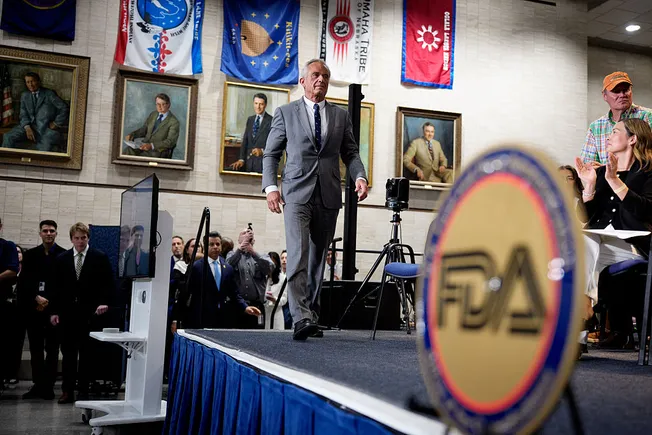Dive Brief:
- The FDA on Tuesday announced it reached an agreement with the food industry to phase out petroleum-based artificial dyes used in everything from sports drinks and yogurt to candy and fruit snacks.
- The agency, alongside the Department of Health and Human Services, will work with food companies to voluntarily remove six synthetic dyes by the end of next year. These include Green No. 3, Red No. 40, Yellow No. 5, Yellow No. 6, Blue No. 1 and Blue No. 2. The FDA is also requesting food companies remove Red. No. 3 sooner than the 2027 requirement.
- The FDA said it will revoke authorization for synthetic food colorings Citrus Red No. 2 and Orange B “within the coming months,” according to an announcement. The agency intends to encourage the use of natural alternatives among food companies and is accelerating approval of at least four natural color additives during the next few weeks.
Dive Insight:
Food companies have faced extensive scrutiny over their ingredients from HHS Secretary Robert F. Kennedy Jr. and the larger “Make America Healthy Again” movement, which blames synthetic dyes as a top contributor to chronic disease and childhood obesity.
Critics argue food dyes can contribute to behavioral problems in children, cause cancer and contribute to overeating by making the foods coloring brighter and more appealing. In Europe, products using these dyes must carry warning labels that say they “may have an adverse effect on activity and attention in children.”
“America's children are sick and suffering,” FDA Commissioner Marty Makary said at a press conference Tuesday, calling the dyes “a toxic soup of synthetic chemicals.”
Still, the FDA's announcement stops short of a full ban, sparking disappointment among some food and health watchdogs who had hoped for more decisive action. Dr. Peter G. Lurie, president of the Center for Science in the Public Interest, noted the FDA is only banning “two rarely used dyes” while largely relying on voluntary commitments from an “unspecified fraction” of the industry.
“We wish Kennedy and Makary well getting these unnecessary and harmful dyes out of the food supply and hope they succeed,” Lurie, who is in favor of banning artificial dyes, said in a statement. “But history tells us that relying on voluntary food industry compliance has all-too-often proven to be a fool’s errand.”
The announcement to phase out petroleum-based dyes comes as policies to eliminate artificial colors gain momentum on the state level. Last month, West Virginia signed into law a bill restricting seven artificial dyes from food products sold in the state. Several other states have introduced bills aimed at food additives, including artificial colors, according to the Environmental Working Group.
Food companies have also faced pressure from consumers. Cereal maker WK Kellogg Co faced protests at its headquarters over the past year from consumers demanding the company remove dyes from products like Froot Loops.
Kennedy, who met with food industry giants including Kraft Heinz, PepsiCo and General Mills earlier this year about removing synthetic colors from their supply chains, said the industry “came to the table” to avoid a patchwork of regulations from states.
“Those bans have given us leverage to make demands of food companies,” he said. “We have them on the run now. And we are going to win this battle.”
Groups representing various sectors of the food industry say they intend to comply with the policy. The International Dairy Foods Association, which represents dairy companies, announced a voluntary commitment to phase out artificial colors from products sold to schools by the start of the 2026-2027 school year.
Meanwhile, the National Confectioners Association said in a statement that U.S. candy makers will “continue to follow regulatory guidance from the authorities in this space, because consumer safety is our chief responsibility and priority.”
Even as food companies seem poised to comply, the industry emphasizes that artificial dyes have been rigorously studied by regulatory agencies and are backed by peer-reviewed scientific research. The Consumer Brands Association, which represents food giants like Kellogg and Coca-Cola, stressed in a statement that these ingredients are safe and that the policy changes are meant to limit consumer confusion amid a growing number of state laws.
“We appreciate that the administration has reasserted their leadership in response to the myriad of state activity in the food regulation space,” Consumer Brands President and CEO Melissa Hockstad said in a statement. “A state patchwork of differing laws creates confusion for consumers, limits access to everyday goods, deters innovation, and increases costs at the grocery store.”
Switching away from artificial colors isn't easy or cheap, however.
The International Association of Color Manufacturers, which represents manufacturers of natural and synthetic dyes, said bans will create new hurdles for food manufacturers as replacing dyes with natural alternatives “is not a simple swap.”
“Overcoming all the challenges created by a nonscientific mandate, including production hurdles, technical limitations, supply chain restraints, increased need for quality control, higher costs, and regulatory inconsistencies, will take more than five years, if not an entire generation,” the association said in a statement following West Virginia's ban.
Sean McBride, founder of DSM Strategic Communications, said the policy upends years of science-based decisionmaking and will raise costs for the food industry without improving health outcomes.
“Disruption for disruption’s sake is not a viable strategy when it comes to public health,” McBride said in an email to Food Dive. “Like Alice in Wonderland, food companies must now learn to operate in an upside-down regulatory world that subjugates due diligence and rational decision-making to the exercise of raw administrative authority.”
Source link
